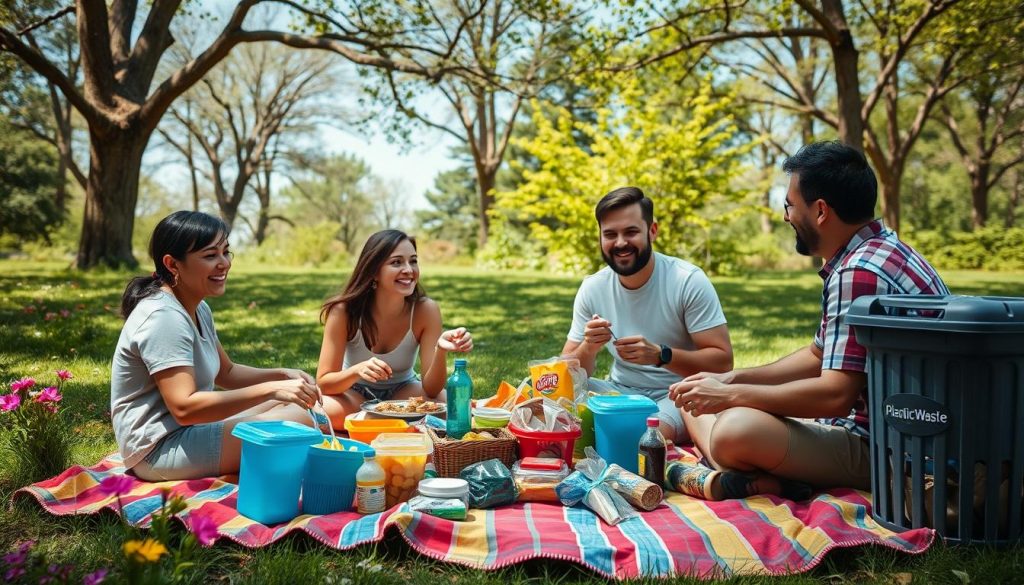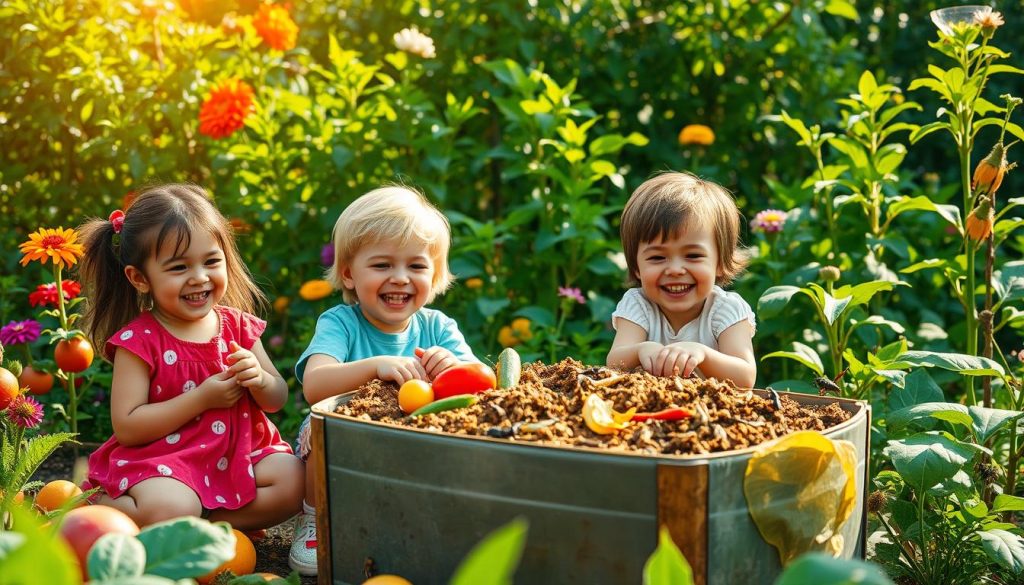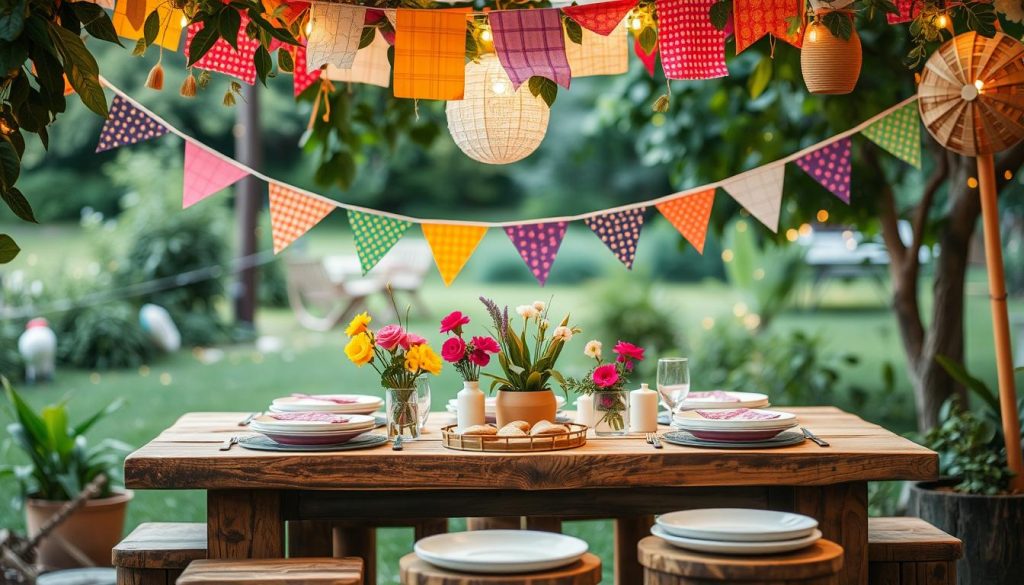I’m excited to share how families can live sustainably through zero waste. As a parent, I’ve found that eco-friendly activities help our planet and teach kids important lessons.
In this guide, we’ll look at ways to cut down on waste and make eco-friendly choices. We’ll also explore how to create a greener future for our kids. From daily habits to fun recycling games, I’ll show you how to make sustainable living a part of your family’s life.
Let’s explore the world of zero waste together. We’ll see how small changes can greatly impact our environment and our kids’ future.
Understanding Zero Waste: A Family Approach
As a parent, I’m always searching for ways to live more eco-friendly. Zero waste for kids and family has really caught my eye. It’s more than just cutting down on trash; it’s a way of life that helps our kids and the planet.
What is Zero Waste?
Zero waste means sending nothing to landfills. It’s about changing how we consume things. We aim to reuse, recycle, or compost everything. For families, it’s about making smart choices every day.
Benefits of Zero Waste Living for Families
Living zero waste has many perks:
- Less harm to the environment
- Save money on household items
- Teach kids important life skills
- Healthier living with fewer chemicals
Setting Realistic Goals for Your Family
Starting a zero waste journey doesn’t mean you have to change everything at once. It’s about setting goals you can reach and making small changes. Here’s a simple guide to help you begin:
| Area | Goal | Action |
|---|---|---|
| Kitchen | Reduce food waste | Plan meals, compost scraps |
| Shopping | Minimize packaging | Use reusable bags, buy in bulk |
| Bathroom | Cut plastic use | Switch to bar soap, bamboo toothbrushes |
Remember, teaching kids about the environment starts at home. By getting them involved in these changes, you’re not just reducing waste. You’re raising the next generation of eco-conscious leaders!
Getting Started: Simple Steps to Reduce Household Waste
I’m excited to share some easy ways to reduce plastic waste and embrace green parenting tips. Let’s start our journey towards a more eco-friendly home!
First, I swap single-use plastics for reusable alternatives. I use cloth bags for groceries, glass containers for leftovers, and stainless steel water bottles. These small changes make a big impact in our effort to reduce plastic waste.
Next, I focus on meal planning. This helps cut down on food waste and unnecessary packaging. I buy in bulk and store items in reusable containers. It’s a win-win – less waste and more savings!
For cleaning, I make my own solutions using vinegar, baking soda, and essential oils. It’s a great way to avoid harsh chemicals and reduce plastic bottle waste. Plus, it’s fun to get the kids involved in mixing up these natural cleaners.
- Use cloth napkins instead of paper
- Opt for bamboo toothbrushes
- Choose plastic-free toys for kids
- Start a small herb garden
These green parenting tips not only help the environment but also teach our children valuable lessons about sustainability. By involving them in these eco-friendly practices, we’re nurturing a generation of mindful consumers.
| Item | Plastic Alternative | Estimated Annual Plastic Reduction |
|---|---|---|
| Grocery Bags | Reusable Cloth Bags | 300-500 bags |
| Water Bottles | Stainless Steel Bottle | 150-200 bottles |
| Food Storage | Glass Containers | 100-150 plastic containers |
| Cleaning Products | DIY Solutions | 20-30 plastic bottles |
Remember, every small step counts. Start with what feels manageable and gradually expand your efforts. Together, we can create a cleaner, greener future for our families!
Zero Waste for Kids and Family: Daily Habits and Routines
Adding sustainable living to our daily life makes a big difference. By doing eco-friendly activities, we help the environment and teach our kids important lessons.
Morning Routines for Eco-Conscious Families
We start our day with simple, green habits. We use reusable water bottles and coffee mugs. We also pack waste-free lunches and turn off lights and electronics before leaving.
These small steps save a lot of energy over time.
Packing Zero Waste Lunches
Packing zero waste lunches is fun for my kids. We use bento boxes, reusable containers, and cloth napkins. It’s a chance for them to help and learn about sustainable living.
It also helps reduce plastic waste and saves money on disposable items.
After-School Activities with a Green Twist
After school, we do eco-friendly activities. We garden, make art from recycled materials, and join community clean-up events. These activities help the environment and encourage creativity and community spirit.
| Activity | Environmental Benefit | Skills Developed |
|---|---|---|
| Gardening | Reduces food miles, increases biodiversity | Patience, responsibility |
| Recycled Art | Reduces waste, promotes upcycling | Creativity, resourcefulness |
| Community Clean-up | Improves local environment, reduces pollution | Teamwork, civic responsibility |
By adding these green habits to our daily life, we’re living more sustainably. It’s amazing to see how these small changes help reduce our environmental impact.
Sustainable Shopping: Teaching Kids About Conscious Consumerism

Teaching kids about sustainable shopping is key in green parenting. I’ve learned that getting kids involved in eco-friendly choices helps them see how their actions affect the planet.
One simple way to cut down on plastic is to use reusable bags. I ask my kids to pick their favorite cloth bags before we go shopping. This small habit greatly reduces single-use plastics.
At the grocery store, I teach my kids to pick items with less packaging. We choose loose fruits and veggies over packaged ones. This not only cuts down on plastic but also promotes healthier eating.
Teaching kids about durable products is another vital lesson. I show them how to find items that last longer, reducing the need for constant replacements. This saves money and cuts down on waste.
- Choose products made from recycled materials
- Opt for items with biodegradable packaging
- Look for local and seasonal products to reduce transportation emissions
By making sustainable choices part of our shopping routine, I’m raising environmentally aware kids. It’s fulfilling to see them make eco-friendly decisions on their own, knowing they’re helping our planet.
Fun Recycling Games and Activities for Children
I love finding fun ways to teach kids about recycling. Simple games can really help them understand waste management. Let’s look at some fun recycling games and upcycling projects that will spark their creativity and teach them about the environment.
DIY Recycling Sorting Game
One of my favorite games is making waste sorting a fun challenge. Set up bins for different materials like paper, plastic, and glass. Give kids a mix of recyclables and time them as they sort items. This activity teaches them how to recycle while they have fun.
Upcycling Crafts for Kids
Upcycling projects teach kids to reuse materials creatively. Try making bird feeders from milk cartons or pencil holders from tin cans. These crafts reduce waste and help kids think creatively and solve problems. They’ll love seeing old items turned into something new.
Organizing a Neighborhood Recycling Challenge
Get the community involved with a recycling competition. Families can compete to collect the most recyclables. This activity promotes teamwork and teaches the importance of recycling. It’s a fun way to help the environment and bring neighbors together.
| Activity | Skills Developed | Materials Needed |
|---|---|---|
| Recycling Sorting Game | Classification, Speed | Bins, Various Recyclables |
| Upcycling Crafts | Creativity, Resourcefulness | Old Items, Craft Supplies |
| Neighborhood Challenge | Teamwork, Community Engagement | Collection Bins, Tracking System |
Introducing Composting to Children: Nature’s Recycling

I love teaching kids about composting! It’s a great way to mix learning with fun. Composting isn’t just about recycling food; it opens up the world of nature’s cycles.
Let’s get to the basics. Composting is like cooking a recipe for the earth. Kids can learn to mix ‘greens’ (like fruit peels and veggie scraps) with ‘browns’ (like dry leaves and paper). This mix makes soil that plants love.
Simple Composting Projects for Families
Here are some easy ways to start:
- Create a worm bin: Kids love watching worms turn scraps into soil.
- Build a backyard compost pile: A family project that teaches teamwork.
- Use a countertop composter: Perfect for apartments or small spaces.
Through these activities, kids learn by doing. They see how their actions can help the earth. It’s a powerful way to teach them about taking care of our planet.
Remember, composting should be fun for kids. Let them get their hands dirty, ask questions, and watch the process. It’s a great way to teach them to care for the earth all their lives.
Minimalism with Kids: Decluttering and Simplifying Family Life
Minimalism with kids can change a family’s life for the better. It helps us live with less stuff. This makes room for more important things like spending time together, being creative, and growing as individuals.
Benefits of Minimalism for Children
Minimalism helps kids focus and feel less stressed. It also makes them more independent. With fewer toys, they use their imaginations more. They learn to value what they have and make smart choices about their belongings.
Strategies for Decluttering Toys and Clothes
We sort through toys and clothes together regularly. We use a simple rule: keep, donate, or recycle. This teaches kids about living zero waste and making choices about their stuff. For clothes, we have capsule wardrobes with pieces that can be mixed and matched.
Teaching Kids to Value Experiences Over Things
I focus on making memories, not buying stuff. We go on adventures, help out in the community, and learn new things together. This teaches my kids that true happiness comes from experiences, not things. Living with less has brought us more joy in our daily lives.
| Minimalist Activity | Benefits |
|---|---|
| Nature walks | Appreciation for outdoors, physical activity |
| DIY projects | Creativity, problem-solving skills |
| Family game nights | Bonding, cognitive development |
Green Parenting Tips: Raising Environmentally Conscious Kids
Raising eco-friendly kids is a rewarding journey. As a parent, I’ve found that teaching green values early on shapes responsible adults. Environmental education starts at home, and there are many fun ways to get kids excited about sustainability.
One of my favorite green parenting tips is to make nature exploration a family activity. We go on weekly hikes, identifying plants and animals. This hands-on approach to environmental education fosters a deep connection with nature. It’s amazing to see how quickly kids become passionate about protecting the environment when they understand its beauty and importance.
Another effective strategy is involving children in eco-friendly household tasks. My kids love helping with our compost bin and garden. It’s a great way to teach them about the lifecycle of food and waste reduction. We also make a game out of finding ways to reduce our energy use, which has significantly lowered our utility bills!
Here are some simple green parenting tips to try:
- Read books about nature and conservation
- Create upcycled art projects
- Start a family vegetable garden
- Volunteer for local environmental causes
- Use reusable containers for school lunches
Remember, the goal is to make environmental education fun and engaging. By incorporating these green parenting tips into daily life, we can raise a generation of environmentally conscious kids ready to tackle the challenges of the future.
Environmental Education: Resources and Activities for Families
I’m excited to share some fantastic resources and activities for environmental education that families can enjoy together. These tools will help kids develop a deep understanding of environmental issues while having fun.
Books are a great way to introduce eco-friendly concepts. I recommend “The Lorax” by Dr. Seuss for younger children and “The One and Only Ivan” by Katherine Applegate for older kids. These stories spark discussions about conservation and animal welfare.
Documentaries can be eye-opening for the whole family. “Planet Earth” and “Our Planet” offer stunning visuals of nature and highlight environmental challenges. They’re perfect for family movie nights with a purpose.
Online resources are abundant for environmental education. Websites like National Geographic Kids and NASA’s Climate Kids offer interactive games and articles that make learning about our planet fun and engaging.
Hands-on eco-friendly activities are crucial for reinforcing environmental concepts. Here are some ideas:
- Start a family vegetable garden
- Create a backyard compost bin
- Build a birdhouse or butterfly feeder
- Organize a neighborhood cleanup day
| Age Group | Environmental Education Activity | Skills Developed |
|---|---|---|
| 3-6 years | Nature scavenger hunt | Observation, nature appreciation |
| 7-10 years | Recycled art projects | Creativity, waste reduction awareness |
| 11-14 years | Energy audit of home | Critical thinking, resource conservation |
By incorporating these resources and activities into your family routine, you’ll foster a love for nature and instill important environmental values in your children.
Zero Waste Celebrations and Parties for Kids

I love throwing parties for my kids, but the waste can be overwhelming. That’s why I’ve started zero waste celebrations for my family. These eco-friendly activities not only reduce our environmental impact but also teach valuable lessons about sustainability.
For decorations, I choose reusable items like fabric banners and cloth tablecloths. We make paper decorations from recycled materials, which is also a fun craft project. Instead of balloons, we create colorful tissue paper pom-poms that can be reused or composted.
When it comes to food, I serve snacks in reusable containers and use real plates and utensils. For drinks, we use glass jars with reusable straws. This approach eliminates single-use plastics and reduces waste significantly.
Party favors can be tricky, but I’ve found some great zero waste options. We give out seed packets, homemade playdough, or small potted plants. These gifts are not only eco-friendly but also encourage further learning and exploration.
| Traditional Party Item | Zero Waste Alternative |
|---|---|
| Disposable plates | Reusable plates or bamboo plates |
| Plastic decorations | Cloth banners, paper decorations |
| Plastic party favors | Seed packets, potted plants |
| Disposable tablecloth | Reusable cloth tablecloth |
By incorporating these zero waste ideas, our family celebrations become meaningful eco-friendly activities. The kids enjoy the creative process, and we all feel good about reducing our environmental impact. It’s a win-win for both our family and the planet!
The Future of Zero Waste: Empowering the Next Generation
Looking ahead, I see a bright future for sustainable living. Teaching kids about zero waste plants seeds for a greener tomorrow. It’s amazing to see how they soak up environmental education.
Children who learn about recycling and reducing waste at home become eco-warriors. They remind their parents to use reusable bags and find creative ways to upcycle. This early education shapes their values and habits for life.
The lessons these kids learn go beyond their families. As they grow, they’ll bring their zero waste knowledge to schools, workplaces, and communities. They’ll be the leaders pushing for better recycling, sustainable products, and eco-friendly policies.
Empowering the next generation with zero waste principles does more than clean up our homes. It sets the stage for a more sustainable world. These kids will face big environmental challenges, but with zero waste knowledge, they’re ready to tackle them.

